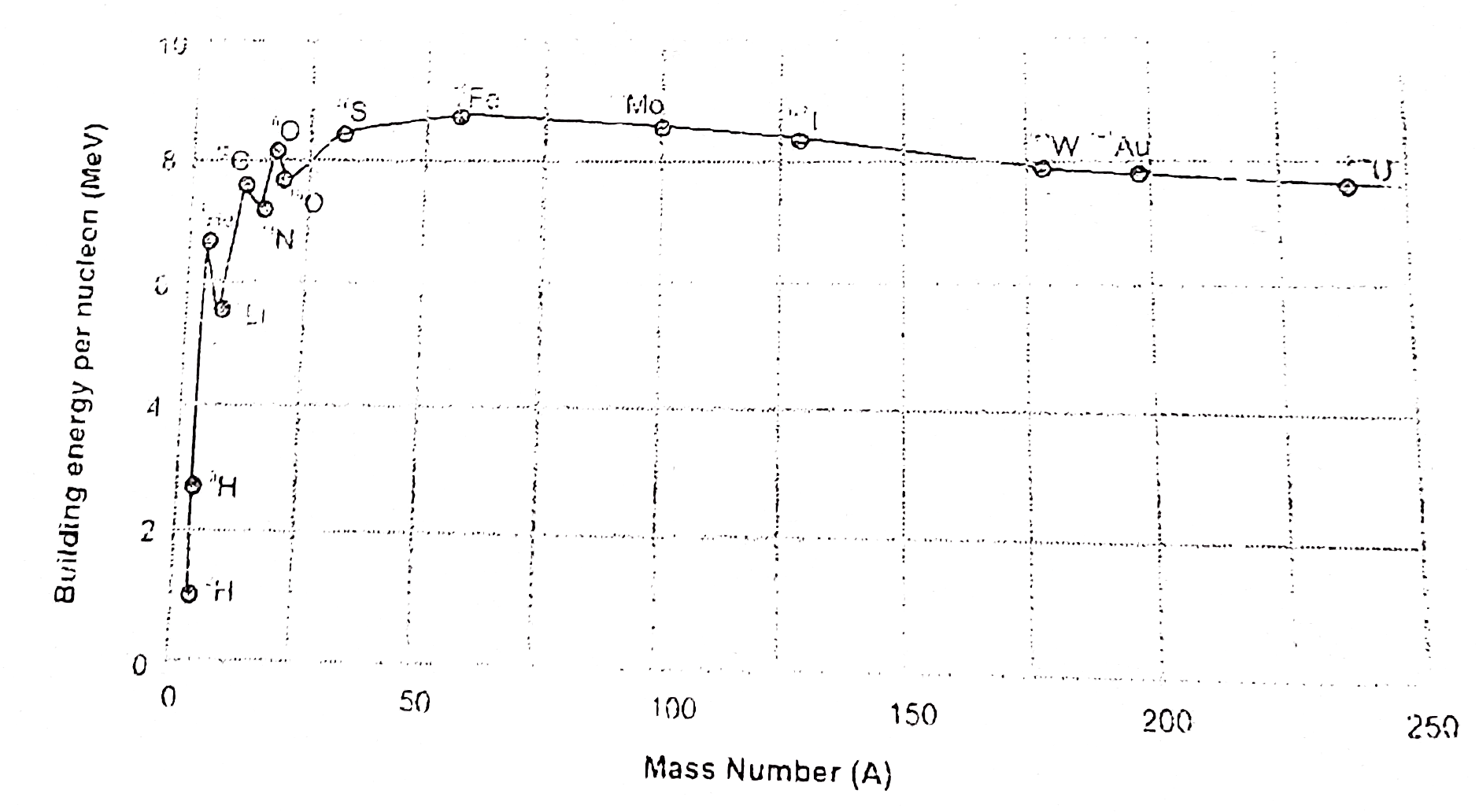Fission of nuclei is possible because the binding energy per nuclei in them
increases with mass number at high mass numbers
decreases with mass number at high mass number
increases with mass number ata low mass number
decreasewith mass number at low mass number
The correct Answer is:b
To solve the question regarding the fission of nuclei and the binding energy per nucleon, we can break it down into several steps:
Step 1: Understand Binding Energy per Nucleon
The binding energy per nucleon is the energy required to remove a nucleon (proton or neutron) from a nucleus. It is a measure of the stability of a nucleus. Higher binding energy per nucleon indicates a more stable nucleus.
Step 2: Analyze the Graph of Binding Energy
In the context of nuclear physics, the graph of binding energy per nucleon versus mass number (A) shows how binding energy changes as the size of the nucleus increases. For lighter nuclei, the binding energy per nucleon tends to increase, reaching a peak around iron (Fe), and then decreases for heavier nuclei.
Step 3: Identify the Process of Fission
Fission is the process where a heavy nucleus splits into two lighter nuclei, releasing energy. This process is favorable when the binding energy per nucleon of the resulting lighter nuclei is greater than that of the original heavy nucleus.
Step 4: Relate Binding Energy to Fission
For heavy nuclei, the binding energy per nucleon decreases as mass number increases. This means that heavy nuclei are less stable and can undergo fission more easily. When they split, the resulting lighter nuclei have a higher binding energy per nucleon, which releases energy.
Step 5: Conclusion
Thus, the fission of nuclei is possible because the binding energy per nucleon decreases with increasing mass number for heavy nuclei. This decrease indicates that heavy nuclei are less stable and can release energy when they undergo fission.
Final Answer
Fission of nuclei is possible because the binding energy per nucleon decreases with increasing mass number in heavy nuclei.
---
The binding energy per nucleon is the energy required to remove a nucleon (proton or neutron) from a nucleus. It is a measure of the stability of a nucleus. Higher binding energy per nucleon indicates a more stable nucleus.
In the context of nuclear physics, the graph of binding energy per nucleon versus mass number (A) shows how binding energy changes as the size of the nucleus increases. For lighter nuclei, the binding energy per nucleon tends to increase, reaching a peak around iron (Fe), and then decreases for heavier nuclei.
Fission is the process where a heavy nucleus splits into two lighter nuclei, releasing energy. This process is favorable when the binding energy per nucleon of the resulting lighter nuclei is greater than that of the original heavy nucleus.
For heavy nuclei, the binding energy per nucleon decreases as mass number increases. This means that heavy nuclei are less stable and can undergo fission more easily. When they split, the resulting lighter nuclei have a higher binding energy per nucleon, which releases energy.
Thus, the fission of nuclei is possible because the binding energy per nucleon decreases with increasing mass number for heavy nuclei. This decrease indicates that heavy nuclei are less stable and can release energy when they undergo fission.
Fission of nuclei is possible because the binding energy per nucleon decreases with increasing mass number in heavy nuclei.
Topper's Solved these Questions
- BOOK - DC PANDEY ENGLISHCHAPTER - NUCLEIEXERCISE - CHECK POINT 13.315videos
NUCLEI
- BOOK - DC PANDEY ENGLISHCHAPTER - NUCLEIEXERCISE - CHAPTER EXERCISES78videos
NUCLEI
- BOOK - DC PANDEY ENGLISHCHAPTER - NUCLEIEXERCISE - checkpoint 13.110videos
NUCLEI
- BOOK - DC PANDEY ENGLISHCHAPTER - MODERN PHYSICS - 2EXERCISE - Level 2 Subjective10videos
MODERN PHYSICS - 2
- BOOK - DC PANDEY ENGLISHCHAPTER - RAY OPTICSEXERCISE - Medical entrance gallary76videos
RAY OPTICS
Similar Questions
The value of binding energy per nucleon is
View SolutionThe binding energy per nucleon is maximum in the case of.
View SolutionThe binding energy per nucleon is maximum in the case of.
View SolutionStatement-1:In a spontaneous fission reaction a heavy nucleus is split into two medium sized ones, each of the new nuclei will have more binding energy per nucleon than the original nucleus
Statement-2:Joining two light nuclei together to give a single nucleus of medium size means more binding energy per nucleon in the new nucleus .View SolutionDraw the graph showing thervariation of binding energy per nucleon with mass number. Give therason for the decrease of binding energy per nucleon for nuclei with high mass numbers.

The binding energy per nucleon for nuclei with high mass number is low due to the large coulomb repulsion between the protons inside these nuclei.View SolutionAssertion: The nuclear energy can be obtained by the nuclear fission of heavier nuclei as well as by fusion of lighter nuclei.
Reason: As the mass number increases, the binding energy per nucleon, first increases and then decreases.View SolutionWhen two nuclei (with A=8) join to form a heavier nucleus , the binding energy (B.E) per nucleon of the heavier nuclei is
View SolutionAssertion : In a nuclear process energy is released if total binding energy of daughter nuclei is more than the total binding energy of parent nuclei.
Reason: If energy is released then total mass of daughter nuclei is less than the total mass of parent nuclei.View SolutionAssertion : In a nuclear process energy is released if total binding energy of daughter nuclei is more than the total binding energy of parent nuclei.
Reason: If energy is released then total mass of daughter nuclei is less than the total mass of parent nuclei.View SolutionAssertion : Nuclei having number about 60 are most stable.
Reason : When two or more light nuclei are combined into a heavier nucleus, then the binding energy per nucleon will increase.View Solution

